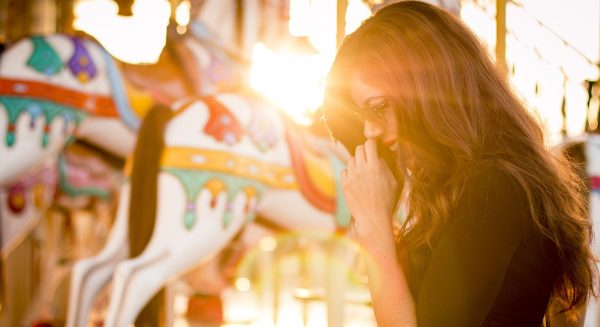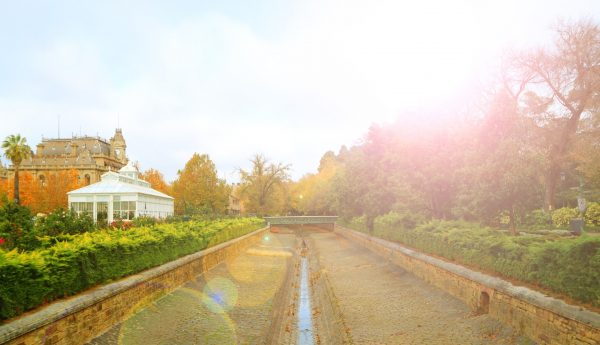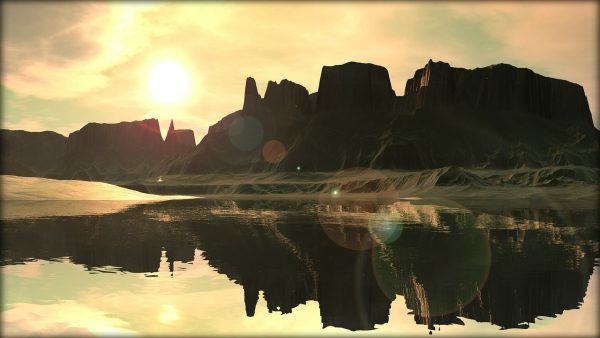Einsteigerguide: Was ist Ghosting und Flare?
Wenn Lichtstrahlen von einer oder mehreren hellen Lichtquellen (wie Sonne oder Kunstlicht) direkt auf das vordere Element einer Kameralinse treffen, können sie verschiedene Linsenelemente, Blenden und sogar Sensoren reflektieren und abprallen, was die Bildqualität beeinträchtigen und unerwünschte Objekte in Bildern erzeugen kann. Besser bekannt als „Flare“, kann der Effekt Bilder auf verschiedene Weise beeinflussen: Er kann den Bildkontrast drastisch reduzieren, indem er Dunst in verschiedenen Farben einbringt, er kann kreisförmige oder halbkreisförmige Halos oder „Geister“ und sogar ungerade, halbtransparente Objekte mit unterschiedlichen Farbintensitäten hinzufügen. Flare ist in der Fotografie jedoch nicht immer unerwünscht – manchmal wird es auch kreativ eingesetzt, um den Bildern künstlerische Elemente hinzuzufügen. In der Tat werden bei Filmen und Computerspielen oft absichtlich Linsenreflexe eingesetzt, um den Eindruck von Realismus zu erwecken und das visuelle Erlebnis des Betrachters zu steigern.

Um zu entscheiden, ob man Flare in Bildern verwenden sollte, muss man zunächst verstehen, warum es überhaupt entsteht. Lassen Sie uns die Ursachen des Aufflackerns im Detail besprechen und dann Möglichkeiten der Verwendung, Reduzierung oder vielleicht sogar vollständigen Vermeidung besprechen.
Was ist Lens Flare?
Streulicht tritt auf, wenn ein Lichtpunkt wie die Sonne viel heller ist als der Rest der Szene und sich entweder im Bild befindet (innerhalb des Blickwinkels der Linse) oder einfach auf das vordere Element eines Objektivs trifft, ohne im Bild vorhanden zu sein. Abhängig von der Position dieser hellen Lichtquelle kann es zu viel Dunst / Kontrastmangel, verstreuten Kugeln und Polygonartefakten im Bild, halbrunden Formen mit Regenbogenfarben oder einer Kombination aus all dem führen. Dies geschieht durch interne Reflexionen, die im Inneren des Objektivs und sogar zwischen dem Bildsensor und dem Objektiv stattfinden.
Wenn Sie sehen können, folgen regelmäßige Lichtstrahlen ihrem normalen Weg und erreichen direkt die Bildebene, während helle Lichtstrahlen sich aufspalten und von den Linsenoberflächen reflektieren können und in verschiedenen Teilen des Rahmens landen. Während der Fahrt durch die Linse kann das Licht auch von der Blende reflektiert werden, wenn es heruntergefahren wird, was zu einem noch deutlicheren Aufblitzen führt.
Hersteller und Fotografen unterscheiden in der Regel zwei Arten von Linsenreflexionen: Veiling und Ghosting Flare. Während beides typischerweise Hand in Hand geht, können gute Objektive mit mehrfach vergüteten Linsenelementoberflächen das Verschleiern von Bildern deutlich reduzieren.
Veiling Flare.
Veiling Flare tritt in der Regel auf, wenn die helle Lichtquelle außerhalb des Sichtwinkels der Linse liegt, d.h. nicht im Bild ist, aber ihre Lichtstrahlen dennoch das vordere Element der Linse erreichen. Dies führt zu einer sehr auffälligem Dunst / Kontrastmangel, bei dem dunkle Bereiche des Rahmens mit blutenden Farben heller werden und verwaschen erscheinen. Hochwertige Objektive mit mehrfach vergüteten Linsenelementen können dazu beitragen, das Verschleiern zu reduzieren. Zum Beispiel hilft die von Nikon entwickelte Nano Crystal Technologie, die bei professionellen Objektiven zum Einsatz kommt, Veiling Flare unter Kontrolle zu halten. Werfen Sie einen Blick auf das untenstehende Portrait, das mit dem Nikon 58 mm f/1.4G Objektiv aufgenommen wurde:

Sie können sehen, dass die Sonne direkt über dem Motiv und außerhalb des Bildbereichs war, aber ihre Lichtstrahlen erreichten immer noch die Linse und verursachten ein verschleierndes Licht um die Frau auf dem Foto. Veiling Flare wirkte sich nicht nur auf die Umgebung der Sonne aus, sondern wirkte sich auch drastisch auf die Haare, das Gesicht und sogar die Kleidung der Frau aus, was zu einem verringerten Kontrast führte. In diesem Fall war es sogar absichtlich erlaubt, Veiling Flare zu verwenden, welche einen stimmungsvollen, hellen Shot lieferte.
Leider kann sich die Verschleierung durch eine Reihe von Faktoren verstärken, wie z.B. Staub im Inneren der Linse, verschmutztes Frontelement, verschmutztes/niedrigwertiges Linsenfilter, fehlende Antireflex-Mehrschichtvergütung etc. In einigen Fällen kann der Effekt in Bildern ziemlich schlecht aussehen. Werfen Sie einen Blick auf das Bild, das mit einem sehr alten Nikon NIKKOR-S 50mm f/1.4 Ai Objektiv mit manuellem Fokus erzeugt wurde:

Wie Sie sehen können, war dieses Objektiv einfach kein guter Kandidat, um gegen die Sonne zu shooten – es ließ das ganze Bild verschwommen aussehen, mit praktisch keinen sichtbaren Details von den Bäumen in der Aufnahme. Eine Ursache war das Fehlen von Mehrbeschichtungstechnologien und ein anderer Teil war Mikrostaub, der sich im Laufe der Jahre im Inneren der Linse ansammelte und zusätzliche Reflexionen verursachte.
Ghosting Flare.
Im Gegensatz zu Veiling Flare, das Bildern mit sehr wenig Kontrast verschwommen erscheinen lässt, stellt das Ghosting Flare oder auch nur das „Ghosting“ alle Artefakte dar, die im Bild sichtbar sind, seien es Reflexionen der hellen Quelle oder Formen, die der Linsenblende sehr ähnlich sind. Diese Kugeln verschiedener Farben und Formen erscheinen normalerweise in einer direkten Linie von der Lichtquelle und können das ganze Bild mit Dutzenden von verschiedenen Artefakten überspannen.
Neben dem sichtbaren Schleierflackern in den Bildern kann man in jedem Bild auch verschiedene kreisförmige Artefakte/Kugeln sehen – diese werden als „Geister“ bezeichnet. Die Gesamtzahl dieser Geister hängt davon ab, wie viele Elemente sich in jedem Objektiv befinden. Je mehr Elemente, desto mehr Geister erscheinen in den Bildern. Da 70-200 mm-Zoomobjektive ein komplexeres Design mit einem Dutzend oder mehr Elemente haben, kann man sehen, dass so ziemlich jedes Objektiv unter Verschleierung und Geisterbildern leidet, wobei Nikon 70-200 mm-Objektive das Spiel mit einem Minimum an Geisterbildern anführen.
Darüber hinaus kann die Blende, wie ich bereits oben erwähnt habe, beim Abschalten einer Linse innere Reflexionen verursachen. Der Effekt wird verstärkt, wenn das Objektiv auf seine minimale Blende heruntergefahren wird, weshalb das Blenden-Ghosting bei großen Blenden wie f/1.4 normalerweise nicht sichtbar ist, aber bei etwas wie f/16 recht auffällig. Wenn Sie also polygonförmige Ghostings in ihren Aufnahmen sehen, wissen Sie einfach, dass diese von der Linsenblende kommen.
Sensor / Rotpunkt Flare.
Als „red dot flare“ bezeichne ich die Fackel, die durch das Aufprallen von Licht zwischen dem Bildsensor und den Linsenelementen entsteht, aber man könnte sie auch „sensor flare“ nennen. Im Gegensatz zur Linsenreflexion ist die rote Punktreflexion nicht nur Licht, das von den Linsenelementen und der Blende reflektiert wird, sondern auch Licht, das vom Bildsensor zum Objektiv und dann zurück zum Bildsensor reflektiert wird. Leider scheinen die neueren spiegellosen Kameras mit kurzen Flachabständen besonders anfällig für dieses Problem zu sein. So sieht der rote Punkt / Sensor Flare in den Bildern aus:

Neben den polygonförmigen Blenden-Ghosting sieht man auch eine Reihe von roten Punkten, die die Sonne umgeben – das sind Mikrolinsen auf dem Digitalkamerasensor, die im Bild verstärkt werden.
Faktoren, die die Fackel beeinflussen.
Während die meisten modernen Objektive mit speziellen Mehrschichtvergütungstechnologien zur Reduzierung von Streulicht entwickelt wurden, können selbst einige der besten professionellen Objektive Bilder mit sichtbarem Ghosting-Bild und sogar verschleierten Streulicht wiedergeben. Denn die Position der Lichtquelle im Rahmen und der Winkel, in dem das Licht auf das Objektiv trifft, haben einen drastischen Einfluss darauf, wie und mit welcher Intensität sich das Licht in den Bildern zeigt. Darüber hinaus gibt es noch weitere Faktoren, die ich oben erwähnt habe und die die Bilder ernsthaft beeinflussen können. Lassen Sie uns einen Blick auf diese Details werfen:
- Linsenelemente – je mehr Linsenelemente, desto mehr Ghostings erscheinen in Bildern.
- Brennweite – Weitwinkelobjektive sind nicht nur für eine gute Handhabung von Streulicht ausgelegt, sondern auch die kürzeren Brennweiten lassen die Lichtquelle kleiner erscheinen. Teleobjektive hingegen sind viel schlechter, weil sie alles verstärken und daher über große/lange Gegenlichtblenden verfügen.
- Linsendesign – ein gutes Linsendesign kann sich definitiv auf die Blende auswirken. So hat Nikon beispielsweise Objektive mit versenkten Frontelementen entwickelt, die ohne den Einsatz teurer Belichtungstechnologien das Aufflackern und Schablonieren stark reduzieren können.
- Multi-Coatings – mehrfach vergütete (MRC) Linsenelemente haben definitiv einen großen Einfluss auf die Leuchtkraft.
- Filter – minderwertige Filter sind dafür bekannt, dass sie mehr Flacker- und Ghostingbilder erzeugen.
- Lens Dust – alle Objektive sammeln Staub über die Zeit an und der innere Staub kann zu weiteren Verschleierungsproblemen führen.
- Sauberkeit des Frontelements – fettige Finger und andere Partikel auf dem Frontelement können ebenfalls zu mehr Aufflackern und Schablonieren führen.
Flare vermeiden.
Wenn Sie in ihren Bildern kein Aufflackern sehen möchten, können Sie einige einfache Schritte unternehmen, um zu verhindern, dass es in ihren Bildern erscheint:
- Verwenden Sie eine Gegenlichtblende – das ist richtig, es gibt einen Grund, warum es diese Gegenlichtblenden gibt. Sie tragen wesentlich dazu bei, dass das direkte Sonnenlicht nicht in das vordere Element gelangt.
- Verwenden Sie ihre Hand oder einen anderen Gegenstand – wenn Sie ihre Hand über die Linse legen, um das Sonnenlicht abzuschirmen, können Sie Ghosting-Bilder und Lichtreflexe vollständig eliminieren. Eine sehr einfache Möglichkeit, die funktioniert.
- Verwenden Sie hochwertige Objektive – hochwertige, pro-grade Objektive sind teuer, aber sie sind meist mit erstaunlichen Beschichtungstechnologien ausgestattet, die dazu beitragen, die Streulichtprobleme deutlich zu reduzieren oder sogar zu eliminieren.
- Verwenden Sie Prime-Linsen anstelle von Zooms – im Allgemeinen haben Prime-Linsen einfachere optische Formeln als Zooms und deutlich weniger optische Elemente. Je weniger Elemente Sie bearbeiten müssen, desto weniger Fackeln erscheinen in den Bildern.
- Wechsel der Perspektive/Rahmen – manchmal kann schon eine Änderung der Position der Lichtquelle in ihrer Aufnahme einen großen Unterschied machen.
Während es leider gängige Praxis ist, die Gegenlichtblende an zu halten und zu wissen, dass Sie das Licht mit ihrer Hand oder anderen Gegenständen blockieren können, wird das Shooting direkt in die Sonne und das Einbeziehen in das Bild diese Bemühungen nutzlos machen. Ändern Sie in solchen Situationen entweder die Perspektive/Rahmen komplett oder verwenden Sie nur hochwertige Objektive mit mehrfach vergüteten Linsenelementen.
One Comment
Comments are closed.



Dank dieses Artikels konnte ich mein Ghosting Problem deutlich minimieren und sogar teilweise ganz lösen, vielen Dank!!